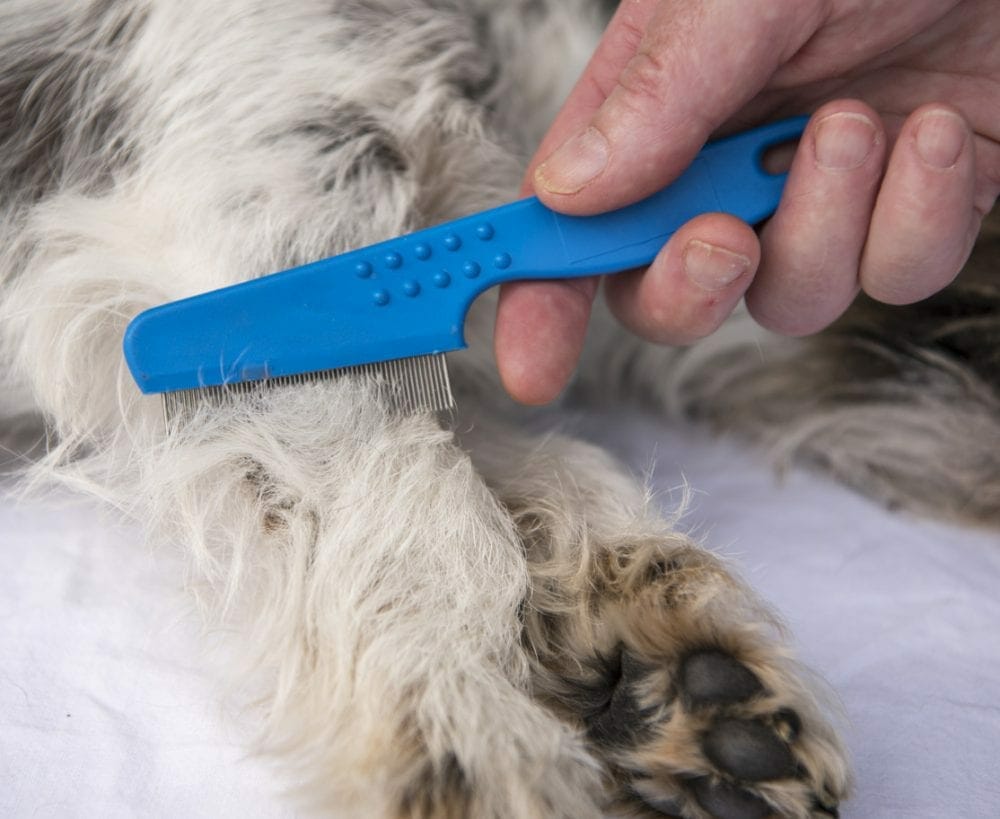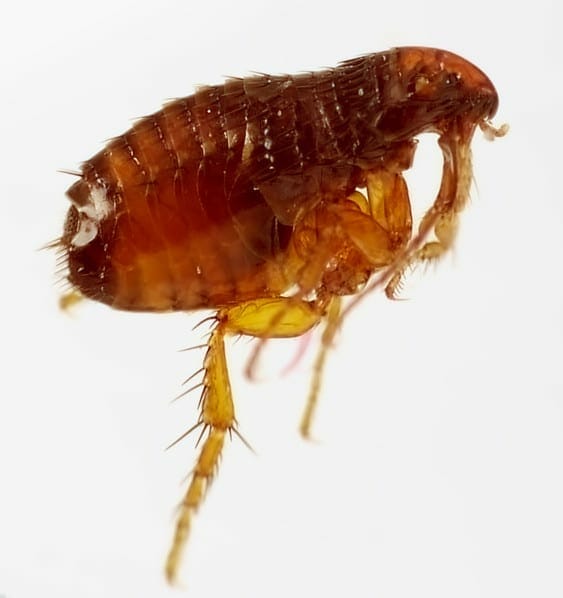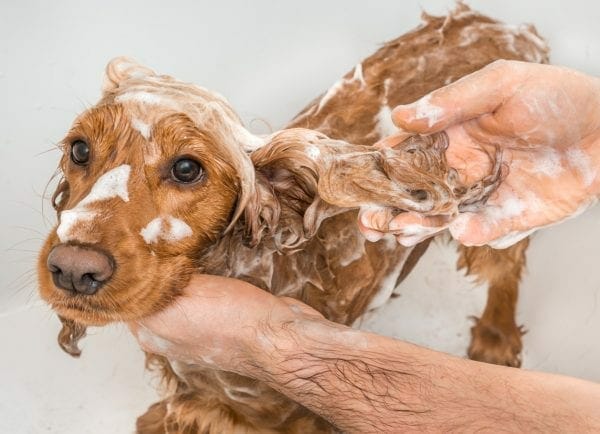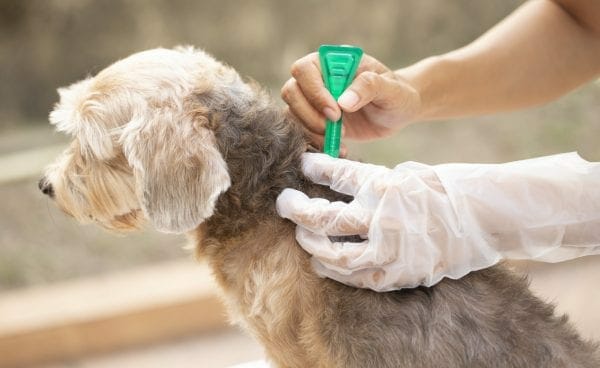How Do Dogs Get Fleas?
Overview of Fleas in Dogs
When it comes to fleas on dogs, the domestic cat flea is the species that afflicts dogs and cats alike. It should not be underestimated simply due to its small size of less than 1/8th of an inch. These tiny but mighty parasites hop from host to host, latching on with their razor-like teeth and taking in their fill of blood.
Combined with their ability to infiltrate into the homes of their host and their rapid patterns of fertility, fleas are no laughing matter to dog owners. Once discovered on a dog, it can be expected that the carpeting, bedding, and furniture in the house the dog lives in could be infested.

How Do Dogs Pick Up Fleas?
Dogs can get fleas from direct contact with another animal with fleas or by playing outside. Grass, plants, and bushes may harbor a dormant flea in the pupa stage, ready to hop onto its next host. A simple brush against these things can be all it takes for a flea to jump on.
The hot months of the year, especially in places with tropical climates, are when the highest numbers of flea infestations are seen in animals. Fleas thrive in warm weather. Dogs living in places that have warm weather throughout the year should be consistently checked for these pesky insects.
What Do Flea Eggs Look Like?
Female fleas are able to deposit about 20 eggs at once. This can occur more than once per day. These eggs often are shaken off of the host’s body and onto the surrounding environment below, which is usually the house where the dog lives. Once they hatch, this is when the infestation begins.
Flea eggs are white, rounded, and approximately half a millimeter long. In other words, they are extremely tiny and easily overlooked.
Flea Life Cycle
 It is important to note that the entire life cycle of a flea can occur in a matter of 1 or 2 months, often unbeknownst to the owner of the dog and the house being infested.
It is important to note that the entire life cycle of a flea can occur in a matter of 1 or 2 months, often unbeknownst to the owner of the dog and the house being infested.
The four life cycles of a flea are:
- Egg: Eggs may take up to a week to hatch.
- Larva: Larvae spend this stage eating and growing.
- Pupa: Pupa have the ability to remain in a cocoon for several months as they await an approaching host to attach to.
- Adult: The adult flea is either eating or reproducing. They can live up to a few months in this stage if they have a consistent host to subsist on.
Once an egg has hatched in a home, a full-blown infestation is right around the corner. Adult females are capable of producing more than 450 eggs during its lifetime, to put it into a palpable perspective.
The moment a flea is suspected or found, measures must be immediately taken to prevent them from spreading and producing.
Signs of Fleas in Dogs
Given the fact a flea’s purpose is to suck the blood from animals, a dog with fleas will undoubtedly show clear indications of agitation and annoyance.
Common signs of fleas in dogs are:
- White gums
- Clawing and scratching
- Inflamed bumps
- Scabs on the skin
- Noticeable fur loss or cuts
Fleas also tend to inhabit the warm, moist areas in a dog, such as around and in the ears and under the legs.
Flea Dirt
When a dog is being checked over for fleas, black splotches may be found on the fur that resemble dirt. In many cases, this is what is known as flea dirt, which is essentially flea waste. These “dirty” places may be an indication that fleas are concentrated in that specific area of the fur, or used to be.
If flea dirt is seen, one can reasonably assume that fleas are now within the spaces that the dog has frequented. Fleas are known to rapidly spread and grow in numbers. While this is, naturally, a horrifying reality for many pet owners, it can be dealt with.
Best Flea Treatment for Dogs
 One of the best ways to initially go about treatment is to give a dog a thorough, sudsy bath with a flea shampoo for dogs. The suds can work to drown the eggs, larva, pupa and adults currently present in the dog’s fur. However, this does not keep these pests away for long.
One of the best ways to initially go about treatment is to give a dog a thorough, sudsy bath with a flea shampoo for dogs. The suds can work to drown the eggs, larva, pupa and adults currently present in the dog’s fur. However, this does not keep these pests away for long.
A secondary means of treatment should be recommended by the dog’s vet based on its age, weight, and medical history. Whether this be through a home remedy, a prescription, a flea collar for dogs, or a medication purchased at a pet store, a vet will know best. This is especially true if this is the first time the dog has contracted fleas.
Not all medications and intervention methods may be safe for every dog, so a discussion with the vet will clear up any questions or concerns.
Flea Medicine for Dogs
Most flea medicine for dogs performs double duty and also kill ticks. Many dog flea medicines offer both flea and tick prevention in dogs. Therefore, one of the best options is to choose a medication that treats both flea and tick for dogs.
Some of the best flea medicine for dogs can be found on reputable sites like Chewy.com, where reviews, recommendations, and instructions can be read to determine the best medication.
Capstar, Bayer Advantage II, and Nexgard are all highly-rated options for medications that can be purchased online. As a reminder, a vet should be seen in order to ensure the safety of the health of the dog before these medications are administered. Just make sure your dog does not have any negative side effects, like diarrhea. Read about some dog diarrhea treatment.

Flea Collar for Dogs and Flea Dip
Many people opt to use a flea collar for dogs instead of administering flea pills for dogs. A wide range of flea collars for dogs are available for purchase, including the Seresto flea and tick collar.
A flea dip for dogs is another viable treatment option that involves a potent solution of pyrethrin’s, which is a natural insecticide. It is worth noting that this is not a 100% safe method for all dogs. Veterinarians are split on the topic of its safety, so its best to consult a vet first before giving a dog a flea dip.

Home Remedy Treatments for Fleas
When it comes to home remedies, research should be conducted to ensure that a chosen method is proven to be effective and safe. While some remedies work tremendously, others have the potential to be toxic.
Many may scour the internet with questions like “does Dawn kill fleas?” or “does vinegar kill fleas?” Luckily for them, both are moderately effective. Even more, they work well when used in tandem.
It is recommended that Dawn soap and vinegar be mixed together to bathe the dog. Dawn soap can effectively kill any fleas currently on the dog, while the smell of vinegar repels any that are left over. While this does not permanently get rid of the fleas, it works to kill off those currently plaguing the dog.
Controversial Home Remedies
The following home remedies are debatable when it comes to their efficacy and safety.
- Diatomaceous Earth for Fleas. This is a powder often used if a house is infested with fleas. It is spread all over the infested areas. Diatomaceous earth should be purchased in food-grade form and should never be used on an animal. This powder is known to adversely affect the lungs of humans. Caution should be heeded with this product.
- Apple Cider Vinegar for Fleas. Because of its low acid levels, apple cider vinegar has been found to be essentially unsuccessful as a flea treatment.
- Tea Tree Oil for Fleas. The only way tea tree oil has been successfully used to deal with fleas is when it is accurately measured out and carefully diluted. If this is not done properly, this oil can be toxic to a dog, in even the smallest amount. It is recommended to avoid this remedy completely.



